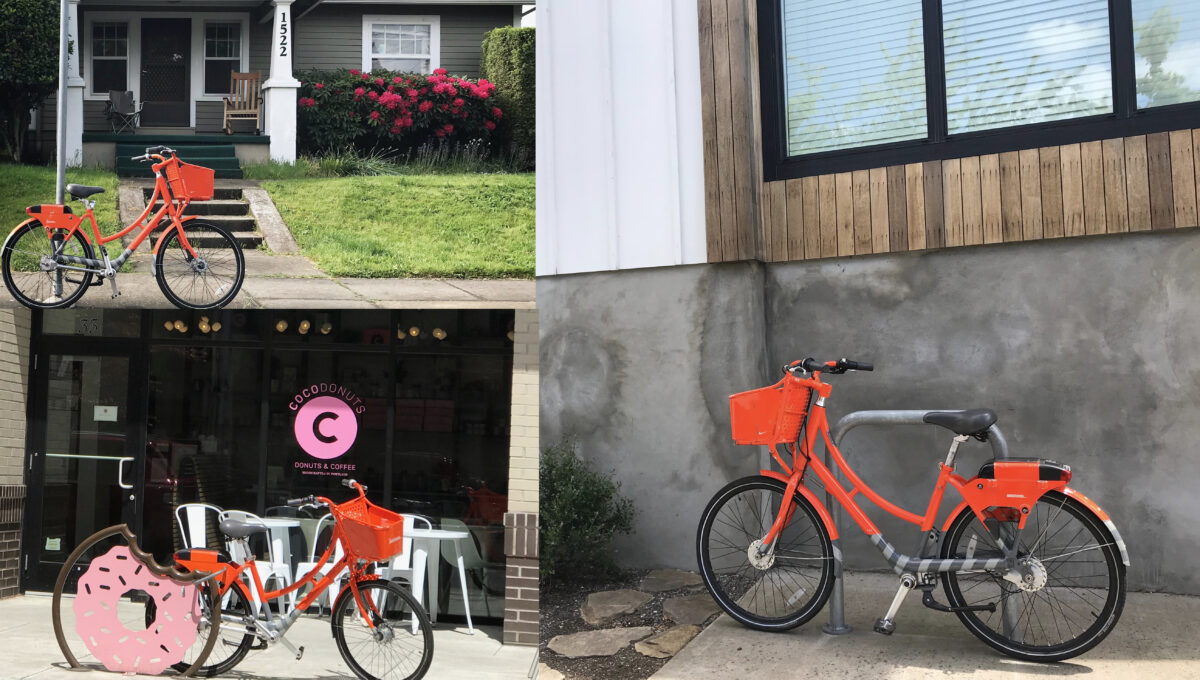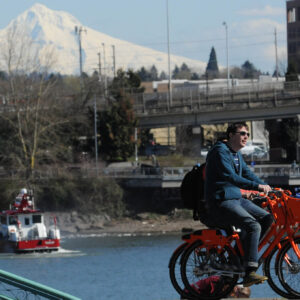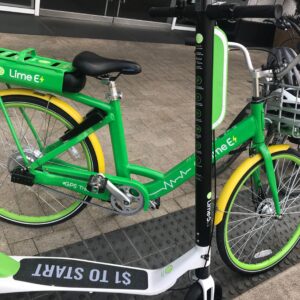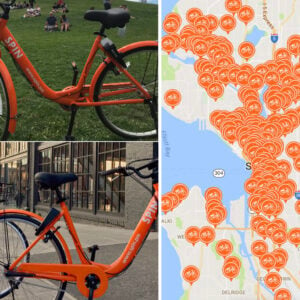
(Photos: J. Maus/BikePortland)
Portland’s experiment with free Biketown rides and parking fee waiver have led to record usage.
The Portland Bureau of Transportation just announced that people have taken 30,238 trips on the system so far this month — a 120 percent increase over the same time last year.
And Biketown broke a new one-day record on Saturday, May 12th with 3,591 rides (the old record of 2,990 rides was on July 30, 2016).
The official, stated reason for the free promotion was National Bike Month (it’s also Bike More Challenge here in Portland); but it’s clear that PBOT wants (needs) to test the waters of a “dockless” system. Dockless bike and electric scooter share systems are transforming how people get around because of they’re more simple to use, more affordable, and easier to access than more traditional, kiosk-based systems. PBOT likes to say that Biketown is already dockless because all the rental software and tech is on the bikes and kiosks aren’t needed; but the parking restrictions and relatively small service area are both very limiting factors.
Also of note is that private firms like Jump, Lime, and others are salivating at the potential of the Portland market for their dockless products. (Unconfirmed word on the street is that PBOT is finalizing a permit process for dockless e-scooter share which should be ready by the end of June.
Advertisement
Whether the free rides or the lack of a $2 fine for parking outside of designated parking zones was the attraction, Portlanders have responded well to more Biketown. Jessica Engelman shared via Twitter today that as an annual member the free rides didn’t influence her usage much. “But not having to pay $2 to park outside of stations certainly did.” Engelman is using the system 275 percent more so far this year compared to last year.
Keep in mind that 1,000 bikes spread out over our existing service area is a very, very small system compared to global best practices. To truly reap the benefits of shared bikes, we need thousands more of them. And, as this experiments proves, they need to be as affordable and accessible as possible.
How has the free ride and parking policy changes impacted you?






Thanks for reading.
BikePortland has served this community with independent community journalism since 2005. We rely on subscriptions from readers like you to survive. Your financial support is vital in keeping this valuable resource alive and well.
Please subscribe today to strengthen and expand our work.
I return out of station bikes while skating around to pay for my membership. This change in policy has resulted in easy pickings. One problem biketown has is the number of broken bikes that still appear on the map. Since they started I’ve come across dozens of broken bikes including three last night. But I’m an unusual user seeking only out of station bikes.
From a convenience standpoint, I strongly prefer dockless. I do wonder how they’ll maintain the bikes properly. Seems like a best case scenario would be to have customers report problems that they would address — a recipe for a low standard of maintenance.
The increased usage is good and I’ve been seeing more people riding them. But given that the bikes are free and dockless (the only thing that could make that better is a larger service area), I’d hope for more. The average rides per day is the same as my commuting bike which has only one rider and much longer trips.
On an aside note, I’ve been seeing fewer of them along BN than expected. In fact, that stretch has had surprisingly few cyclists even at prime time considering the perfect weather, full separation, and free bikes close by.
I wish the service area was at least comparable to the car-share service area… right now I’m 2.5 miles from the nearest BikeTown border, and inside both the ReachNow and car2go service areas…
so when I need to go one-way to meet somebody who won’t be biking with me my choices are clear: wait for the bus…
What does the no-charge model do to the budget? They don’t advertise anything but Nike. Has there been a bump in membership?
Also: we need more bike racks, and bike/scooter drop zones or corrals. Put them on the corners and it will improve sight lines at intersections.
Aren’t people still subject to a fine if a bike is parked outside of the service area? Or have those fines been waived for May as well?
Confused about this as well. The headline seems to imply that you can ride outside of the service are?
That’s why I put “(nearly) anywhere” in the headline. I thought that made it clear that the free parking is only within the service area. Don’t I also mention that in the post? Sorry for any confusion.
Yes it’s $10. I wasn’t paying attention over the weekend and locked up outside the zone. Oh well 🙂
The highest usage is a Saturday? When it’s super nice weather? Doesn’t that pretty much say that this is a hobby and not a mode of transportation? All the people riding these bikes along the river?
Biketown is pretty much a weekend tourist rental service. Whenever I see someone on one of these bikes, they’re all over the place, on the sidewalks, in the street, riding against traffic……
I give them wide clearance.
If Portland is aiming for a 25% bike mode share, now you have some notion of what kind of behavior to expect from the 20-28% of users who are “interested but concerned” when they bike on busier streets. This kind of behavior is the norm in “bronze” level cities with few on-street bike amenities, people riding on sidewalks, riding on-street against traffic flow, no lights, etc. To get to your 25% level, you need to accommodate such behavior to a large extent by providing wider sidewalks, “open” streets, protected bike lanes on busy streets, and city-wide bike share. And now you know that not only will it cost a lot of money you don’t have and political will your elected officials are reluctant to use, but you yourselves will also have to make various sacrifices of what you are willing to tolerate.
25% bike share is not realistic. I think it looks goofy to pretend otherwise.
Most people are not willing to get messy, uncomfortable, expend much effort, take noticeably longer than alternative modes of transport, or feel threatened. There are many articles and posts on BP that attest to all of these factors, and better infrastructure only improves the last one.
Unless the 25% is tightly defined — for example to able bodied commuters between 25 and 55 who have less than 3 1/2 miles each way on flattish terrain in good weather — it’s not going to happen.
Wow Kyle, this comment really helps me understand your perspective.
You are correct, mode share (any mode) is generally defined as the “primary” means of transport for working-age people who actually commute for work, usually 16-70 and employed as defined by the IRS & Social Security (people who file W2s). The unemployed, cash-based workers, students who don’t work, and many others are not counted, as is riding for any purpose other than commuting to work; in the US, this works out to about 62% of the population (the current US employment rate) is counted and 38% are not.
Unlike you, I think the goal of Portland reaching 25% within this 62% is achievable, but it will be difficult and very challenging.
The reason I think it’s totally unrealistic boils down to two data points that no amount of infrastructure will change:
1) The average Portland commute is 7 miles each way
2) Riding conditions often involve cold/heat/rain/darkness
The people for whom either applies and are still willing to ride are in a minority much smaller than 25% — raising this number requires more of a change in human nature than infrastructure.
Even on a forum dedicated to cycling such as BP, many view riding in any kind of conditions as some kind of hardship. To make cycling work, you need to embrace what comes along with it. Most people aren’t interested in doing that, and something big (such as the quintipling of gas prices) would be necessary to change that.
1. Commute distance can change with changes in land use and employment proximity, especially as more jobs move towards regional centers such as Gateway & Gresham and people live closer to where they work (e.g. more housing near downtown.)
2. Weather/Darkness – these conditions also exist in even harsher environments and longer winter nights with already heavy bike usage, such as Cambridge & York UK; everywhere in the Netherlands and Denmark (and most of the rest of Europe; and of course in the great white north, eh? – in Vancouver, Toronto, & Montreal.
Either of these factors requires a major reconfiguration of society — a very long term process.
Reducing distances requires significantly greater population density, something that there is little support for even here since actually accomplishing that would require a lot of single family housing to be replaced with multitenant buildings. One reason people commute long distances is the high cost of housing closer in.
Regional centers will help. However, multi earner households are the rule rather than the exception which means not everyone can live close to where they work. That’s before we throw in that jobs keep getting less stable.
I agree there’s not much to Portland weather. That does not change peoples’ willingness to go out in it. When people who already ride when it’s nice quit when it’s less than perfect, there’s no basis for thinking people who aren’t interested in riding to begin with will be out there.
When housing that’s commensurate with what jobs are paying is built — i.e., truly affordable housing — then we might see some progress. Because not everyone who rides for transportation is affluent and/or lives close-in.
maybe had they stocked up at both ends of the Max detour and offered people bikes to get around the closure? There are ways they could really target this to foster the kind of use needed to help achieve that number?
They could set up with hundreds of bikes outside a timbers game and offer people another way home?
I’m honestly having difficulty parsing this comment.
Are you seriously implying that more people on bicycles would be a bad thing, just because they may be inexperienced or have different riding habits than ours? I’ll joyfully take that over our current car-centric paradigm any day. Hell, I’d prefer streets full of people that just learned to ride their bikes over streets choked with loud, polluting cars and their impatient, distracted drivers.
What would be your response if 70% of people who were using bikes were either riding on sidewalks (often narrow ones) and/or against the usual traffic flow? In most of the USA, that is how most cyclists, in terms of different users of the “interested but concerned 26%”, ride.
You may be right, but I gotta say that I prefer tourists riding bikes than driving around on streets they are unfamiliar with and making sudden, poor decisions.
I see people riding them during commute times so it’s not just tourists. Also, in certain areas with good station density like NW west of 405 you will see a ton of locals using them to run errands, groceries, etc.
I don’t like the bikes, but am taking one from my building in the Lloyd district to a downtown meeting tomorrow at lunchtime. I had a bike partially, clumsily stripped in my last mid-day meeting in Old Town, and I’ll suffer an awkward ride instead of parking my own there. Jury duty next week, so another two days of risking a bike other than my own.
I’m appreciating the availability – I gave up my membership after the first year, because I only joined to help the program have a base of annual members. I didn’t use it, but perhaps these bikes will serve my needs on occasion.
If someone decides to go for a drive just for fun (I know people that do this) is that considered a hobby or transportation?
For the census, driving to work is “transportation” while driving for fun or for shopping is “other”. I too know people who sincerely enjoy the youthful zest of top-down motoring.
I’m fortunate to work downtown and have meetings throughout my days in various places. In the past I’d have walked or ridden my own bike. Using BikeTown instead means I save a lot of time and/or hassle of either walking or riding my own bike. So it is I’ve ridden 1000 miles in 803 trips. If you still think BikeTown is just for tourists then you fail to see how it benefits residents too. They are also quite fast if you know how to ride them, which most people don’t.
Do tell, Phil!
I find the orange bikes to be heavy and slow. They’re great for a downhill ride, tolerable on flat terrain, brutal with an incline. I ride an old heavy Breezer and I’ve long regretted buying such a heavy bike, but whenever I jump on an orange bike I’m reminded: it could be worse! Ironically, I think that using such heavy bikes could actually be discouraging new riders rather than getting them excited about the possibility of commuting by bike.
I think we should keep the orange clunkers but also open the door to competition from dockless e-bikes and e-scooters. A 7-mile commute feels a lot shorter on an e-assist bike, so adding e-bikes would bring a whole new swath of commuters into the fold. And adding geofenced “islands” of dockless e-scooters in a 1-2 mile radius around outlying MAX stations — especially those with parking constraints and nearby employment centers — seems like an obvious move.
Unless PBOT is hellbent on preserving BIKETOWN’s monopoly.
One thing’s pretty clear to me: the current system, though better than nothing, is far short of optimal. BIKETOWN is already considered “old school” by international bikeshare standards, and Portland’s not going to make a lot of progress toward our mode split goals without trying other approaches. Seattle and San Francisco have opened the door to innovation, and while the results are messy, they’re seeng far more adoption than we are.
I actually love the way the bikes ride! They feel super cushy and comfortable, and the way the fat tires roll smoothly over busted pavement is great. The geometry is such that I can put a toe down when stopped, and no chain means my pants and shoes don’t get greasy. Of course, they’re not fast to get up the hills, but I appreciate that they have enough low gears that I’ve never had a problem. To each their own, I suppose!
Steve, So most think they are heavy and slow, while I’ve experienced them being heavy and fast. Here is why and how: Normally when I ride I try to stick with a cadence that keeps the bike feeling efficiently fast enough, while staying w/in the constraints of my own physical abilities. I keep my legs moving including while shifting to stay within my comfort level for the slope and distance of the ride. On Biketown, I’ve found it more efficient to pedal in short bursts to take advantage of the weight and coasting ability of the bike. Most importantly is shifting when NOT pedaling. Gaining momentum through these short bursts helps take advantage of the bikes weight and coasting ability. It is also far less taxing on the body than a constant cadence like we are accustomed to. I’m happy to meet up for a ride to show you exactly what I’m talking about. Give it a shot!
We live in NoPo outside of the bike share boundary and have an 11-yr old who is not big enough to pedal one, so they don’t get used as much as they could. However, because of the Bike Month promotion and easier bike parking, my wife has used it a lot this month!
I’ve been loving this promotion! There have been more bikes available right outside my office, so it’s even more convenient than usual. I took a co-worker who hadn’t biked in years on a lunchtime Biketown ride this week, and she had a great time. I hope they continue to make parking wherever free!
It’s a great promotion and the sort of big risky thing Biketown needs to be doing to rattle more people who live in the service area into using it – especially before venture-capital-subsidized private bike share arrives. The clock is ticking on Motivate’s three-year commitment to cover any financial losses Biketown might incur, and the public’s obligation to Nike lasts two years beyond the end of that.
Seems like the experiment in how annual members respond to full docklessness might be even more important than how occasional users respond to it being free.
Wonder what would happen if transit were free for a month–nah, too risky.
For my birthday, or for Bastille Day, or Hanukkah or something, I’d still like to see TriMet, the City of Portland, and ODOT get together and optimize a transit route. No fares (or prepaid fares), a clear bus lane, tow trucks to keep it clear, and enough buses to run a 5 minute schedule. Lots of publicity. Would it be hard? Sorta. Would it cost money? Yes. Would it cost $450,000,000 or, you know, point six billion? Not even close.
Sure that was off topic. So what? I read all that stuff about parenting.
I agree. In Corvallis transit is “free,” (i.e. paid through citizens utility bill). On a recent trip to Boise GreenBike was free (mimicking Biketown’s promotion), but so was transit for the month of May. TriMet would be wise to run such a promotion, but only if they provided reliable service. Transit fares are a form of regressive taxation.
“1,000 bikes spread out over our existing service area is a very, very small system compared to global best practices. To truly reap the benefits of shared bikes, we need thousands more of them. And, as this experiments proves, they need to be as affordable and accessible as possible” – Yes! That is an accurate assessment. Love the parking fee waiver for Biketown, and it should really be continued. But we need to add more bikes into the system, especially in the densest areas of the city (e.g. Pearl, NW, Goose Hollow, etc) to make it more convenient to use.
Communists!
I’m loving it.
I have an annual membership (and usually manage to score enough rebalancing credits during the month to pay for the next month) so the ‘free’ part doesn’t excite me. But the dockless part is so much more convenient. I’ve been finding bikes everywhere – right outside the grocery store, a block from the playhouse, as soon as I walk into the home area – so I don’t have to walk all the way to a hub to grab one. (Now, if they’d only extend the home area another quarter mile to reach my house.)
So, if the orange bikes can be parked anywhere, I can park my own bike on the orange racks? Is that part of the deal?
there was a homeless person’s shopping cart at the one by Lloyd center the other day. With a lock and everything.
If an orange bike is on a public rack, can I store my lock on it? 😉
Another program destined to failure like all the past yellow bikes paid by taxpayers and destroyed by the users. Keep the toys off the streets. You have narrowed the car lanes putting all parties in greater danger and increasing the fatalities for auto passengers/drivers pedestrians, and more specifically for the very users of these toys whom you claim to be helping by using toys for transportation. Bicycles and scooters of all kinds are toys. Keep them on the sidewalks and hold them responsible for their actions against pedestrians.
What a nice day for a ride! Dry, not too hot, not too bright, beautiful spring flowers, foliage, and yards getting all prettied up. I’ve got a spare bike you can borrow, with lots of seat adjustment. Wanna go for a ride?
Right, another parodist. Secret handshake to you!
Note: the yellow bikes were actually put on the street by Christians (their founder told them to give away their worldly goods to secure a place in the afterlifr)
Yep, dockless is taking off. Docked requires piles of cash to run.